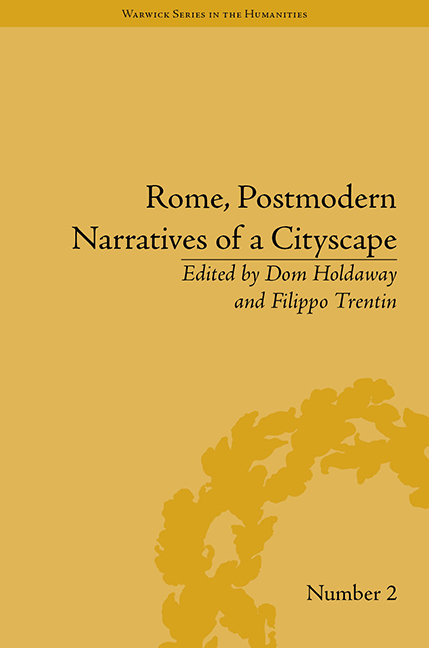Book contents
- Frontmatter
- Contents
- Acknowledgements
- List of Contributors
- List of Figures
- Introduction: Rome, Postmodern Narratives of a Cityscape
- Part I Knowing Rome
- Part II Fragmented Topography
- Part III Situating Rome
- 7 Ecclesiastical Icons: Defining Rome through Architectural Exchange
- 8 ‘Roma Interrotta’: Postmodern Rome as the Source of Fragmented Narratives
- 9 Las Vegas by Way of Rome: The Eternal City and American Postmodernism
- Notes
- Index
7 - Ecclesiastical Icons: Defining Rome through Architectural Exchange
from Part III - Situating Rome
- Frontmatter
- Contents
- Acknowledgements
- List of Contributors
- List of Figures
- Introduction: Rome, Postmodern Narratives of a Cityscape
- Part I Knowing Rome
- Part II Fragmented Topography
- Part III Situating Rome
- 7 Ecclesiastical Icons: Defining Rome through Architectural Exchange
- 8 ‘Roma Interrotta’: Postmodern Rome as the Source of Fragmented Narratives
- 9 Las Vegas by Way of Rome: The Eternal City and American Postmodernism
- Notes
- Index
Summary
Introduction
This chapter will discuss the way in which many of the churches of the twentieth-century Roman suburbs can aid us in our reading of Rome today. This premise supports the notion of a pluralistic rather than a singular narrative; it is the suggestion of a narrative that has developed outside the Aurelian Walls and therefore peripherally to the gravitas of the traditionally held perspective of the Eternal City. It is hoped that such a reading will be reinforced in considering the sense of architectural dialogue or exchange present in the transition from one iconic architectural epoch to another, namely modernism to postmodernism. Crucially, the role of the Second Vatican Council (1962–5), occurring at the interface of these two philosophies, will be taken into consideration. Specifically I will consider the importance and bearing of Vatican II on the future design philosophy and aesthetic of the Catholic Church in Rome and internationally, and consequently its ability to influence the way in which we read the evolution of this most enigmatic of cities will be foregrounded as an alternative trajectory to de facto postmodernism. Support of this thesis, with the aim of shedding light on ecclesiastical development, will be suggested throughout in several ways. First, I will allude to the depiction of Rome in key texts of the modernist cinema of early 1960s Italy.
- Type
- Chapter
- Information
- Rome, Postmodern Narratives of a Cityscape , pp. 137 - 154Publisher: Pickering & ChattoFirst published in: 2014



